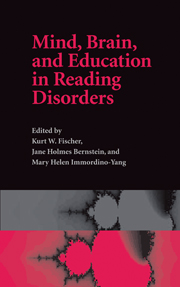Book contents
- Frontmatter
- Contents
- List of figures
- List of tables
- List of contributors
- Acknowledgements
- Part I What is Reading, and What are Reading Disorders? Looking to Neuroscience, Evolution, and Genetics
- Part II Reading and the Growing Brain: Methodology and History
- Part III Watching Children Read
- Part IV Reading Skills in the Long Term
- 15 The importance of comprehension in reading problems and instruction
- Essay: Bring reading research to the trenches
- 16 What successful adults with dyslexia teach educators about children
- 17 Is a synthesis possible? Making doubly sure in research and application
- Appendix: Transcript and behavioral data from Profiles in Reading Skills (Four Boys)
- Index
- References
17 - Is a synthesis possible? Making doubly sure in research and application
Published online by Cambridge University Press: 22 September 2009
- Frontmatter
- Contents
- List of figures
- List of tables
- List of contributors
- Acknowledgements
- Part I What is Reading, and What are Reading Disorders? Looking to Neuroscience, Evolution, and Genetics
- Part II Reading and the Growing Brain: Methodology and History
- Part III Watching Children Read
- Part IV Reading Skills in the Long Term
- 15 The importance of comprehension in reading problems and instruction
- Essay: Bring reading research to the trenches
- 16 What successful adults with dyslexia teach educators about children
- 17 Is a synthesis possible? Making doubly sure in research and application
- Appendix: Transcript and behavioral data from Profiles in Reading Skills (Four Boys)
- Index
- References
Summary
Overview: While most research on dyslexia focuses, not surprisingly, on reading, David Rose cautions against an overly narrow vision of reading and dyslexia. Borrowing the concept of double dissociation from neuropsychological lesion studies, Rose suggests expanding the horizon of inquiry into other skills and populations than those directly related to reading or reading difficulties. This broader horizon leads to better understanding of what makes dyslexic children different as well as which of their skills, broadly conceived, are relevant to the reading process. For example, many children with reading disabilities typically also function poorly on various non-reading tasks. More specifically, Braille reading in blind children highlights that being competent at reading comprehension and spelling requires ample exposure to print and skill at eye scanning (or finger scanning of Braille) – aspects of the printed world that are limited for the blind. From an educational perspective, this broader approach facilitates creating the most effective interventions, which must make use of children's relative strengths, remediate their weaknesses, and address a wide range of relevant skill areas.
The EditorsFrom the outset, I want to confess that I am a recovering neuropsychologist. For the last fifteen years I have tried to abstain from the practice of neuropsychology in favor of my day job – the design of educational technology. I have not been entirely successful, however, because most of the students for whom my colleagues and I at CAST (Center for Applied Special Technology) have been designing educational technology present either subtle or dramatic neuro-psychological problems.
- Type
- Chapter
- Information
- Mind, Brain, and Education in Reading Disorders , pp. 282 - 292Publisher: Cambridge University PressPrint publication year: 2007

